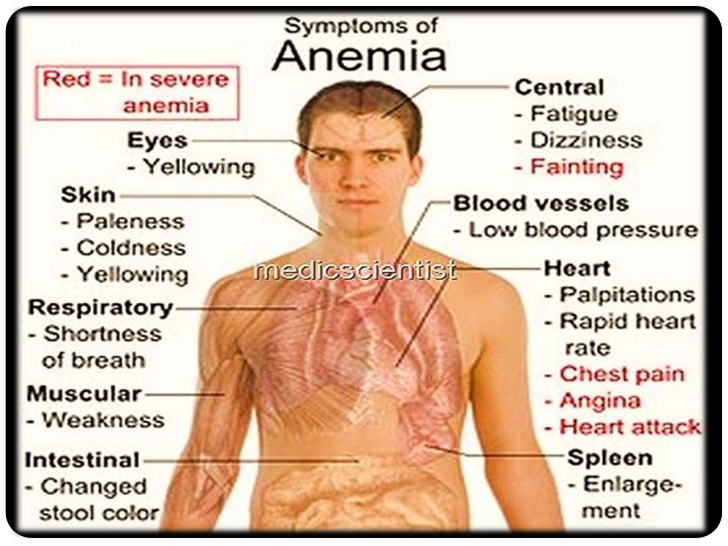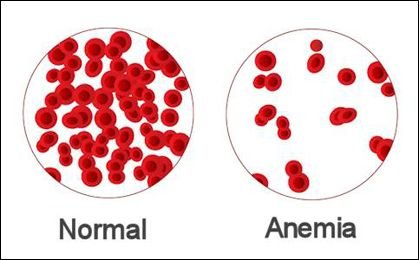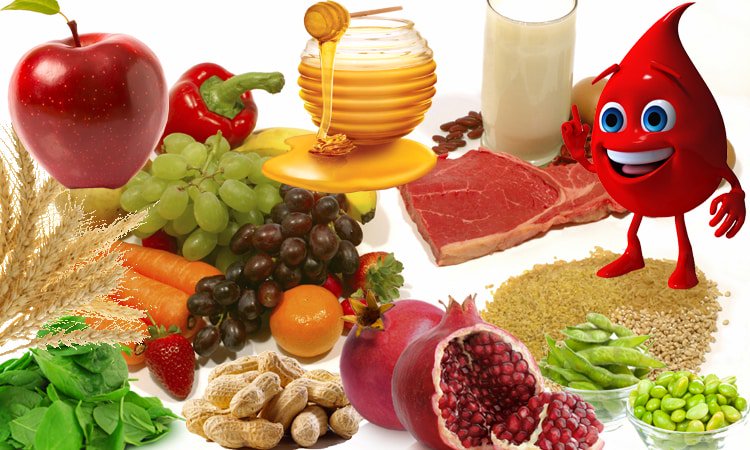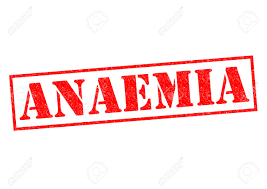
Hello friends!
Its me Anil mehta from Nepal,a medical students posting some information about anaemia "which is a clinical condition in which there is significant decrease in the quantity of hemoglobin".Do read everyone and give your valuable advice and suggestion.
Anaemia
It is defined as the qualitative or quantitative diminution of RBC and / or haemoglobin concentra tion in relation to standard age and sex, and is clinically manifested by pallor. It is not a disease but denotes manifestation of some disease, and thus a cause must be searched for.

Where will you look for anaemia ? Sites :
Lower palpebral conjunctiva (retract the lower eyelids downward and ask the patient to look upwards — both eyes at a time).
Tongue, specially the tip and the dorsum.
Mucous membrane of palate.
Nail-beds (press the pulp to see the redness of nail-bed).
Palms, soles and general skin surfaces.
- Nail-beds are the windows of the cutaneous capillary network.
Clinical types of anaemia and its bedside assessment :
Anaemia is clinically classified as mild, moderate and severe types. It is totally a clinical assessment (highly subjective sign) and may not correspond with laboratory findings. Clinically we see the paleness of the skin/mucous membrane, or pallor. The colour of the tongue as well as the conjunctiva are more reliable than other sites in this respect (in adults). In children, palms and soles are to be specially looked for.
Clinical classification :
Mild anaemia — 60-80% of Hb (9-12 g/dl). Moderate anaemia — 40-60% of Hb (6-9 g/dl). Severe anaemia — < 40% of Hb (< 6 g/dl).
The normal haemoglobin concentrations in case of males and females are. Males — 14.6 to 15.5 g/dl, and females — 13.3 to 14.6 g/dl. - Clinically, 14.5 g/dl may be taken as 100%.
Causes of ‘pallor without anaemia’ :
See the section on 'Myxoedema'. - Pallor (paleness) is the waxy appearance of skin and mucous membrane. It depends on thickness and quality of skin, and quality and amount of blood in the capillaries. Thus, pallor and anaemia are not interchangeable terms. There are many causes of pallor, and anaemia is commonest of them. Pallor of mucous membrane is commonly due to anaemia; very often generalised pallor is attributed to severe anaemia. It is difficult to detect pallor in deeply pigmented individuals.

Anaemia is a pathological condition while pallor is a clinical entity. A person without losing a drop of blood may become deadly pale (shock and collapse), and similarly a person looking severely pale may not be grossly anaemic (Sheehan’s syndrome).
*** Facial pallor is commonly seen in shock and low cardric outputs state.
general survey, one may write pallor (probably a better terminology) instead of anaemia.
Examination of the hands in anaemia :
Colour nail-beds and palms give an indication of presence of anaemia.
Koilonychia gives a clue to the type of anaemia, such as iron deficiency anaemia.
In severe anaemia, there may be capillary pulsation.
Presence of splinter haemorrhage or Osier’s node points towards SBE.
Anaemia with finger deformities may indicate rheumatoid arthritis.
Colour of palmar creases gives a clue to the degree of anaemia. When they are as pale as the
surrounding skin, the patient usually has haemoglobin level < 7 g/dl.

- In ophthalmoscopy if the retina seems very pale, the haemoglobin concentration is usually < 4 g/dl. ** Jaundice associated with anaemia points towards haemolytic anaemia.
Haemoglobin concentration is 81%-99% : is it anaemia ?
Yes, it is anaemia but the pallor may not be clinically evident (so this group is not included in the
clinical classification of anaemia).
Symptoms referable to anaemia :
Weakness, fatigue, lassitude, light-headedness, giddiness, fainting or syncope, anorexia, palpita
tion, breathlessness, anginal pain, insomnia, tinnitus, lack of concentration, intermittent claudication, tingling sensation in the extremities and menstrual irregularities are common symptoms.
Importance of ‘history taking’ in a patient of anaemia :
Present history—commonly complaining of easy fatiguability, shortness of breath and decreased effort intolerance.
Past history—H/O bleeding (e.g., menorrhagia or haemorrhoids), H/O blood transfusion in the past or diarrhoea (tropical sprue).
Personal history—alcohol consumption, walking bare-footed (e.g., hookworm infestation).
Family history—similar type of illness in the family suggests genetic inheritance, e.g.,
thalassaemia, HbE disease, haemophilia.Dietary history—should be taken to diagnose nutritional anaemia (e.g., ture vegetarians may
suffer form vitamin B12 deficiency anaemia); less intake due to anorexia, dysphagia or poverty.Treatment history—Bone marrow suppresant drugs, NSAID-intake or H/O radiation.
Occupational history—H/O exposure to chemical solvents, lead, benzene, insecticides should
be taken; a cultivator working bare-footed may suffer from hookworm infestation.Geographic background and ethnic origin—Important to diagnose thalassaemia, sickle cell
anaemia, G6PD deficiency.

Important history to evaluate anaemia :
H/O chronic blood loss (bleeding peptic ulcer, haemorrhoids, menorrhagia), malabsorption (diar- rhoea/steatorrhoea), nutritional intake, worm infestations, exposure to drugs/chemicals/radiation, bleed ing tendencies, bowel habits, anorexia and loss of weight.
Common causes of severe anaemia in your hospital :
Nutritional.
Hookworm infestation.
Haematemesis and melaena.
Chronic bleeding haemorrhoids.
Aplastic anaemia.
Importance of stool examination in anaemia ;
Presence of occult blood.
To diagnose hookworm ova.

Classify anaemia (working classification) :
- Acute leukaemias. 7. Thalassaemia.
- Uraemia.
- Menorrhagia.
- Carcinoma of stomach, lung, colon.
(A) (B)
Based on morphology : normocytic, microcytic, macrocytic. Based on aetiology :
. a) Blood loss, which may be acute or chronic.
. b) Inadequate production of RBC.
. c) Excessive destruction of RBC.
the bone marrow.
It seems anaemia may result from nutritional deficiency, haemorrhage, haemolysis or hypoplasia of
Cardiovascular (CVS) features in severe anaemia :
Tachycardia.
Capillary pulsation.
Water-hammer pulse.
Cervical venous hum.
Cardiomegaly (cardiac dilatation) and later signs of heart failure.
Hyperdynamic apex beat.
Mitral systolic murmur due to functional MI (ring dilatation).
Haemic murmur over the pulmonary area.
Rarely mid-diastolic (non-rumbling) murmur in mitral area may be auscultated (due to relative
stenosis at mitral valve) secondary to Increased blood flow.
- No. 1, 3, 5 and 8 are most important.
Features in other systems in severe anaemia :
- General survey
Ankle oedema in anaemia :
a) Pallor b) Dyspnoea c) Ankle oedema or anasarca. Already described above.
Hepatosplenornegaly may be present.
Basal crepitations.
Features of polyneuropathy; sometimes, there is papilloedema - CVS
- G.I. tract
- Respiratory system
- Nervous system
- Lymphoreticular system
There may be presence of sternal tenderness. - Severe anaemia per se (renal retention of salt and water).
- Congestive cardiac failure may be associated with.
- Associated renal or hepatic disorders, hypoalbuminaemia, myxoedema.

Common causes of anaemia in this part of world : - Nutritional anaemia (so, dietary history is important).
- Hookworm infestation.
- Chronic malaria, chronic kala-azar, tuberculosis.
- Thalassaemia.
- Tropical sprue.

- Transfusion is usually required when Hb level goes below 7 g/dl. One unit (2 units in India) of packed red cells elevates the haemoglobin by approximately 1 g/dl.
** Globally, ‘chronic blood loss’ is probably the commonest
Common causes of iron deficiency anaemia :
Nutritional deficiency.
Bleeding peptic ulcer.
Gastric erosion by NSAID.
Bleeding haemorrhoids.

cause of anaemia.Hookworm infestation.
Malabsorption syndrome. 7. Menorrhagia.
Pregnancy, lactation.
- This Is why stool is examined for ova/parasite/cyst/occult blood, upper and lower G.I. endoscopy are performed with barium study, and gynaecological evaluation are done for ‘chronic blood loss’.
Clinical diagnosis of iron deficiency anaemia :
H/O ‘pica’ (eating of strange non-nutrient items such as clay—geophagia, ice—pagophagia, cornstarch—amylophagia, or coal) or chronic blood loss from G. I. tract.
Pallor (pearly white sclera).
Glossitis (bald or depapillated tongue)
Angular stomatitis, cheilosis.
Brittle finger nails, flat nails (platynychia) or even koilonychia.
Brittle hairs.
Dysphagia (Plummer-Vinson syndrome or Paterson-Kelly syndrome) as a result of post-cricoid
web which can be demonstrated endoscopically or by barium swallow.Mild splenomegaly, rarely.
- ‘Pica' (i.e., perverted appetite) is also observed in pregnancy and some psychiatric disorder.
Diet is important to prevent anaemia


So this all for today health steemians. Hope to see you on other health post.
Thanks,
with love
anilmehta00

I really learnt something new today! Thanks keep such content incoming really appreciate such content here!
Downvoting a post can decrease pending rewards and make it less visible. Common reasons:
Submit
@originalworks
Downvoting a post can decrease pending rewards and make it less visible. Common reasons:
Submit
Congratulations @anilmehta00! You have completed some achievement on Steemit and have been rewarded with new badge(s) :
Click on any badge to view your own Board of Honor on SteemitBoard.
For more information about SteemitBoard, click here
If you no longer want to receive notifications, reply to this comment with the word
STOPDownvoting a post can decrease pending rewards and make it less visible. Common reasons:
Submit
Nice article .. keep up the good work.
Downvoting a post can decrease pending rewards and make it less visible. Common reasons:
Submit
This post has received a 0.03 % upvote from @boomerang thanks to: @anilmehta00
@boomerang distributes 100% of the SBD and up to 80% of the Curation Rewards to STEEM POWER Delegators. If you want to bid for votes or want to delegate SP please read the @boomerang whitepaper.
Downvoting a post can decrease pending rewards and make it less visible. Common reasons:
Submit